Reenvisioning a Fractured Global Food System
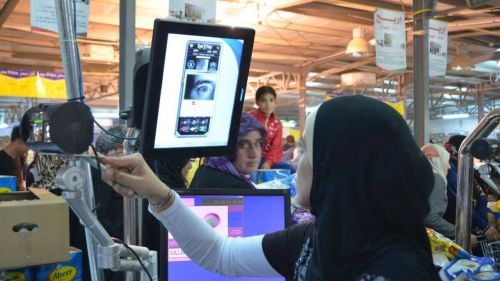
Unlocking local knowledge and know-how in Regional Innovation Hubs.
The World Food Programme (WFP) has been innovating in humanitarian response throughout its 60-year history, starting with the first airlift in 1962 using commercial airlines to deliver food assistance to otherwise inaccessible areas of northern Iran. Since then WFP has introduced innovations ranging from hydroponic cultivation for growing food in deserts and refugee camps, to artificial intelligence tracking and predicting food insecurity around the world. Our mission is dedicated to achieving the Sustainable Development Goal (SDG) 2 of Zero Hunger. One of the key targets of this goal is Ensuring Sustainable Food Systems. In addition to emergency response, WFP's work also builds resilience, strengthens food supply chains, enhances smallholder farmers’ market access, and more. Over the last year, the COVID-19 pandemic has created new challenges in accessing and delivering assistance to populations facing food insecurity and has disrupted food systems.
Food systems encompass everything from the farming and production to the delivery and distribution of food. Supply of farming inputs, like seed, fertilizer, irrigation; the delivery of food and produce to markets; and direct sales to consumers or distribution through school kitchens. In 2020, about 300 million children whose only food source was WFP’s school meal programs were left hungry due to programs that were shut down by pandemic physical distancing measures.
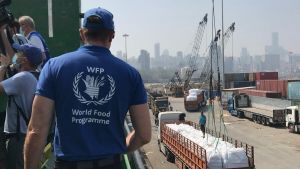
Disasters like the August 2020 explosion in the Port of Beirut disrupted food systems in Lebanon. WFP responded by shipping in tons of food assistance, supported by donors.
Food systems are regularly disrupted by conflict, climate shocks, and natural or anthropogenic disasters. WFP is currently responding to at least 10 countries facing acute food insecurity, verging on the possibility of famine. WFP has rolled out hydroponic cultivation projects to empower refugee communities in deserts, and quickly mobilized food distributions following the explosion in Beirut’s shipping port in August 2020.
These circumstances not only highlight the vulnerability of food systems, but also demonstrate how adapting to changing contexts and leveraging local strengths are crucial. We at WFP have been looking at how to build resilience in global food systems, and we see regional innovation hubs as a key puzzle piece to support and build connections between local resources and future needs.
Concentrations of Knowledge, Resources, and Opportunities
WFP Innovation Accelerator has been supporting specific spots in the world that are well positioned geographically, economically, and technologically to inform regional and global responses to food insecurity. People most affected by food insecurity are the best positioned to frame the problems, identify resources, and inform solutions.
At the beginning of the COVID-19 pandemic, food insecure people in South Sudan were increasingly faced with food shortages. WFP responded with the COVID-19 Fast Track innovation challenge, to quickly source innovations to address food security and expedite the implementation at speed and scale. One of the solutions, Retail in a Box provides an instant marketplace set-up for remote refugee camps based on the idea of nimble pop-up shops. WFP delivers cash-based transfers of humanitarian assistance to people and gives them the purchasing power to make their own choices of goods and services based on their individual needs. When they spend digital cash, they buy locally grown produce, it stimulates the local economy, supporting the shopkeeper, the farmers, and the resilience of the local food system.
One of our more forward looking innovation challenges was the recent WFP-X Moonshot Launchpad that focused on urban food security in Dar es Salaam, Tanzania. With the world population growing and rapid urbanization in step, people in the world’s megacities of 10+ million are at risk of food insecurity. WFP-X mobilized local innovators to map out the local food system and make workable solutions to address hunger with local resources - such as using endemic gum arabic coatings to extend the life of produce. Innovators also identified opportunities to build up nascent solutions such as farming insects to produce alternate proteins.
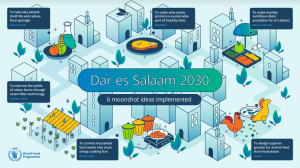 Play Video
Play Video
WFP-X explored moonshot innovations for the megacities of the future, such as Dar es Salaam, Tanzania, leveraging local innovation, knowledge and resources.
Similar regional innovation activities are happening at WFP’s regional innovation hubs in Amman, Jordan; Bogotá, Colombia; and Nairobi, Kenya. Hubs will also develop a community ecosystem of innovators and entrepreneurs across geographies to share learnings and build capacity, including through more South-South collaborations. They know the local communities, they feel the push and pull dynamics of the supply chain, and they can connect sectors to cooperate.
The Potential of Unusual Partnerships between Public and Private Sector
We are seeing convergence on the need to leverage new ways of working together between different actors, ranging from the public and private sectors to startups, to strengthen food systems, and change how food is produced, distributed, and consumed. The humanitarian innovation projects that we at the WFP Innovation Accelerator have seeded and scaled demonstrate how innovation can transform food production in the most challenging places, and engage local smallholder farmers in the agri-economy. These proven concepts need to be supported for further growth, scaled for impact, and integrated into the overarching food system. These innovations positively impacted a total of 3.7 million people in 2020 alone. Similarly, key regional WFP field offices have mobilized support and resources to not only respond to food crises, but to get ahead of problems and envision new ways to address future needs. With this in mind, we have been supporting the development of regional innovation hubs to incorporate local knowledge and the resources available to develop appropriate solutions to present day and future challenges.
The World Economic Forum (WEF) made a call for attention in “How Food Innovation Hubs Will Scale Technology To Transform Our Food System.” In it, Saswati Bora, Head of Food Systems Innovation, WEF, writes: ”technology and innovation provide enormous opportunities to make food systems inclusive, efficient, sustainable, nutritious and healthy. However, no one stakeholder is able to navigate the complexities of food systems on their own to meet the necessary scale and impact.”
While technology and innovation are proving successful, WFP Executive Director, David Beasley, underscored in a WEF panel discussion that “Achieving Zero Hunger requires investment from the private sector – we will never reach our goal without them. The Regional Food Innovation Hubs provide a vital opportunity to bring together some of the world’s leading organizations, from many different sectors, to support the global movement to end hunger.”
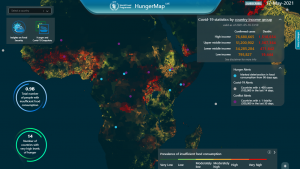
Partnerships help power the A.I. backbone of WFP’s HungerMapLive dashboard for monitoring food crises around the world.
Partnerships and a multi-sector approach have helped WFP make important advances, by providing technology such as AI in our monitoring systems, robotics engineering for our supply chain logistics, to mentoring social entrepreneurs in our innovation program, or funding for our humanitarian field operations in over 80 countries; and this is only the beginning. New partnerships are needed to support the development of our regional innovation hubs that are still in their early stages, who are on a similar growth path of a start-up. In turn, partners can get much closer to helping solve these important challenges, stimulating innovation ecosystems, and strengthening a vulnerable global food system.
Partnerships can open new opportunities, like outfitting WFP’s amphibious all-terrain vehicle with robotic engineering for remote-operation, which will enable WFP to deliver assistance to even the most dangerous last mile.
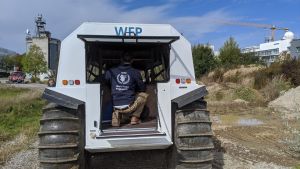

Strengthening the Global Food System: The UN Food Systems Summit
The world needs to think differently about food. It’s not only a commodity, it’s a basic human requirement. And while 690 million people go to bed hungry every night and 10 countries are on the brink of famine, over 2 billion people are overweight and ⅓ of all food produced is wasted. These are not isolated problems but indications of systemic issues. While progress towards Zero Hunger has been made over the years, our capacity to beat hunger is being outstripped by cycles of crises: conflict, climate shocks, inequality, and most recently the COVID-19 pandemic. WFP has 6 decades of experience dealing with food crises, and we are bringing innovative and bold solutions to transform food systems globally.
We are preparing to discuss the role of regional innovation hubs at the upcoming UN Food Systems Summit in September 2021. WFP’s humanitarian assistance programs address each of the five action tracks of the Food Systems Summit:
Action Track 1: Ensuring access to safe and nutritious food for all;
Action Track 2: Shifting to sustainable consumption patterns;
Action Track 3: Boost nature-positive production;
Action Track 4: Advance equitable livelihoods; and
Action Track 5: Build resilience to vulnerabilities in shocks and stress.
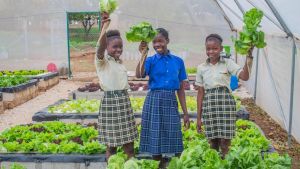
Students at Bulungu School in Zambia, harvest vegetables grown with WFP’s H2Grow hydroponics programme for their school meals.
WFP innovations address each of the above with accessible school feeding programs, a digital app to help formulate school meal menus based on local produce to meet recommended dietary and nutritional guidelines; knowledge transfer of climate-resilient H2Grow hydroponic cultivation techniques for South-South and refugee-to-refugee collaborations; empowering smallholder farmers’ participation in the agri-economy; enabling Building Blocks digital cash transfers to support local livelihoods; and finally building up regional innovation hubs in order to actively engage the local ecosystem to participate and strengthen itself, and build resilience to future challenges. We hope other institutions, partners, donors, innovators and producers will join us in this vision of regional innovation hubs to build a more inclusive world and work towards Zero Hunger, so that no one is left behind.
"Harvesting Tomorrow" Series
- How One Plant Breeder Innovates to Tackle Potato’s Biggest Challenge
- Could a Data Sharing Protocol be Agriculture's Missing Link?
- When Intermediary Links in the Supply Chain are Weakened, the Whole Food System…
- We Can't Shoot for the Moon without Space Technology
- Good Nutrition Today is Key to Harvesting a Better Tomorrow
- Bridging Gaps to Achieve Good Food for All
- From Simple to Great, from Past to Future
- Global Food Security Symposium Highlights Innovation
- Food Security Recovery is More Affordable than You Think
- From Molecule to Market: Using Innovative Plant Breeding to Build Global Food S…
- Closing Investment Gaps in African Aquatic Foods
- Reenvisioning a Fractured Global Food System
- Dietary Diversity for Women Improves Nutrition Security for All
- A Gender-Responsive Approach to Natural Resources